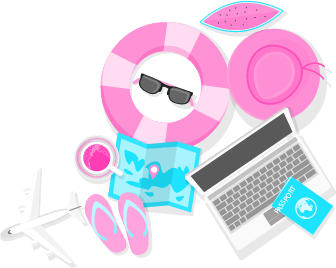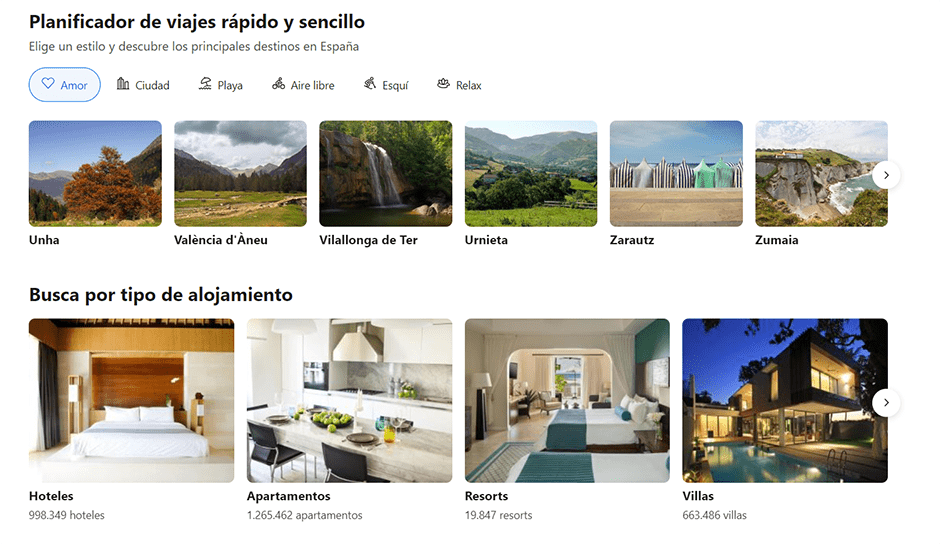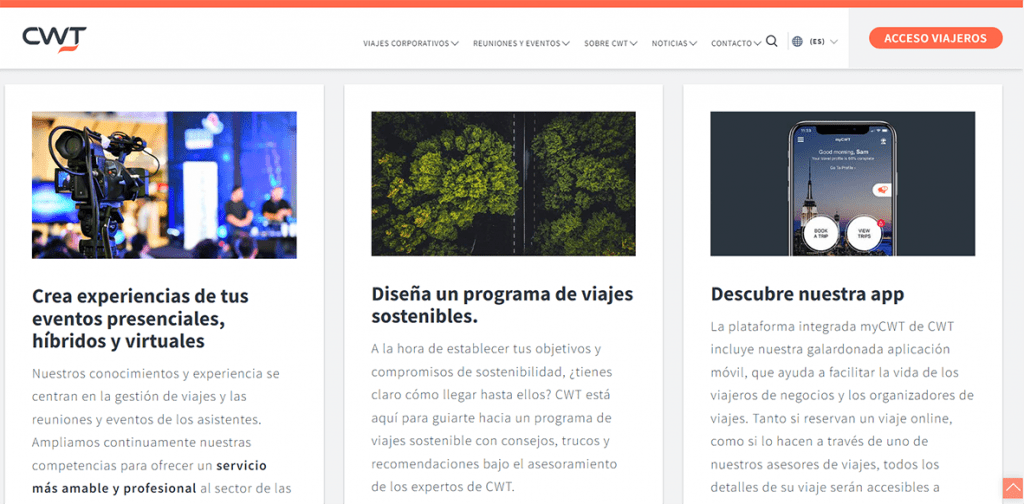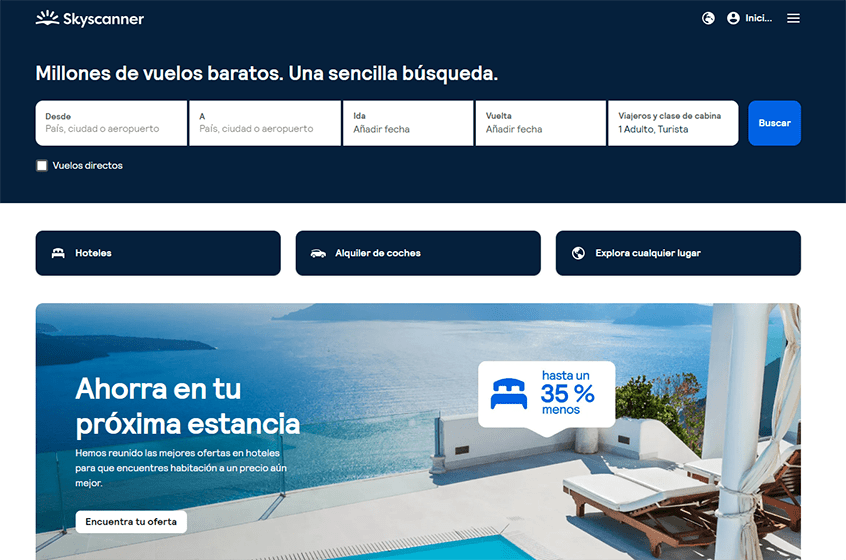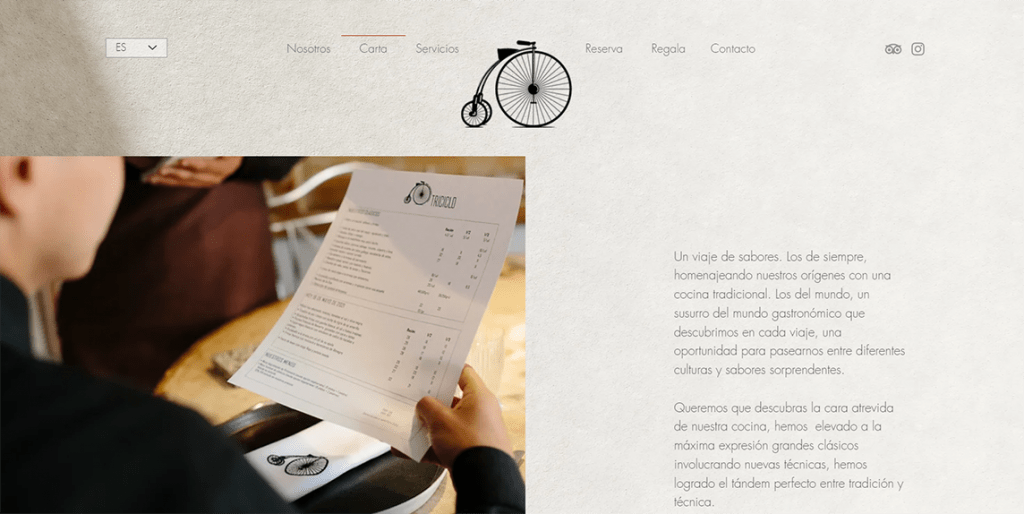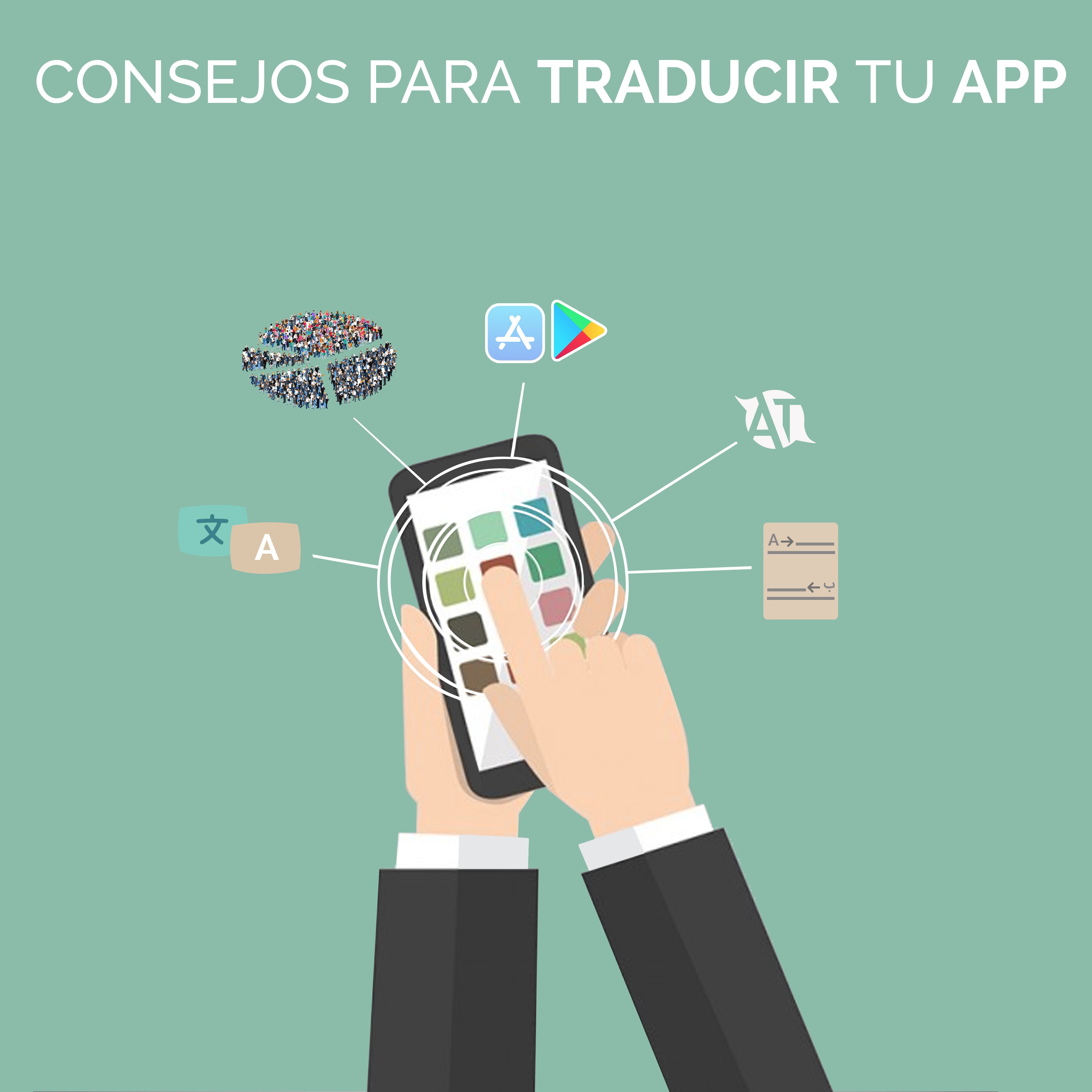Travel copywriting: how to attract customers to your business

Keywords: copywriting, copywriting tips, travel copywriting, hotel copywriting
Whether you're organising a trip in the high, medium or low season, tourism copywriting is your year-round planning partner. Didn't you notice? It's only natural; one of the whole points of persuasive writing is exactly that: to connect with you without you even realising. And that's no bad thing! It's quite the opposite. If you think about it another way, services, destinations, hotels and a whole world of other travel and dining options would remain in the dark (and you'd never stumble upon them, no matter how hard you tried!).
Wondering how you could use this type of copywriting to your advantage, and attract tourists to your services? Grab your ticket and get on board to learn some travel copywriting tips and tricks. Worth a shot? After all, it's about the journey as well as the destination... 😉
Find out how you can attract more customers with travel copywriting:
- What is persuasive writing or copywriting?
- What is copywriting in tourism?
- How can you use travel or hotel copywriting to attract more tourists and customers?
- Persuasive writing techniques to magnetise tourists
- What are the key things to think about in travel copywriting?
- Does travel and hotel copywriting apply to the digital realm only?
- How can you measure the results of persuasive writing in tourism?
- Examples of travel copywriting
- How to choose a tourism copywriting company
What is persuasive writing or copywriting?
What does persuasive writing actually mean? Generally used for commercial purposes, it involves writing text with the concrete aim of capturing the reader. You can use a wide range of strategies to do this. One such example is talking to your potential customers in familiar - but no less proper - language. Another, researching your audience to get a clear picture of your ideal customer; one who will go on to buy your product or service.
Let's put it out there... persuasive writing: friend or foe? This marketing communications strategy is extremely useful for various types of texts, and at ATLS we're absolutely sure which side we're on: It's more than a friend. It's your essential, supportive rock when it comes to making sure your services find their destination in our ever-more digitalised world.
Why is persuasive writing so important?
It's no secret that digital content writing just keeps getting more important over time. Having the skill to use words to prove your product's worth is a great achievement. It's no easy task to get your customers hooked in when reading about your products, services or website product descriptions. You've got a few seconds max to make a good enough impression to get their curiosity burning. And how do you that? It's all about the content writing.
We're not saying you need to trick your reader - far from it. It's a question of finding the most attractive way possible to get them to acquire a product. A quality service needs to follow in the footsteps of the copywriting... If not, persuasive writing won't work for you, no matter how much you want it to.
SEO is one of the most important aspects of strong content writing. It ensures the keywords your business uses direct your potential customers down the right route to their destination (in this case, your products). Nobody likes getting lost before they've even set off on their trip!
What is copywriting in tourism?
Just as copywriting attracts customers' attention to a range of products and services, a travel copywriter channels their attention to the intended destination - this time, the tourism sector. We're talking about hotels, accommodation and places of interest, monuments, restaurants, car rental companies and any other similar services you can think of.
The work of a travel copywriter is far from simple: they need to get customers to fall in love with the text and give them the full tourist experience - before they've even set foot in the place they're thinking about travelling to. You want your reader to feel those butterflies in their stomach, like a crush!
This is precisely what this kind of persuasive writing aims to achieve: the sentences used to draw in tourists aren't there for the sake of mere selling; rather, empathising with them and stirring up a whole host of positive emotions. The more you empathise with your customer, the more likely they are to allow themselves to be influenced by what you're telling them. There's no use in talking about how they'll benefit if they choose you, or explaining how great your services are; they need to see it to believe it. Through your words.
The advantages of investing in tourism copywriting
On the one hand, travel copywriting (or hotel copywriting if that's more your area) gives you a fantastic opportunity to work out - and set - your own prices. Yes, you heard it right. If you offer premium quality, high-end tourism services, and you can show it through your copywriting, why not increase your prices in line with that added value, given that your products are worth it, right?
Similarly, you'll avoid any unwanted competition. After all, you'll be able to stop measuring yourself against your competitors and being driven down on price - because your customers will simply choose you. Quality before (lower) quantity. As well as all that, if you hand over the hard work to a specialist travel copywriting company, you'll have much more time to spend on your business, and that means more profits.
Come to think of it, competition in the tourism industry is a bit like being in the jungle: sometimes, the survival of the fittest is the strongest law there is. Which is why you should have a strong base of travel copywriting to protect you from predators. On top of that, it gives you a wild (but still safe) path forward, thanks to persuasive writing techniques and SEO optimization.
What's the difference between travel copywriting and plain old copywriting?
People often think that content writing and copywriting are strictly for websites, but that couldn't be further from the truth. In fact, whilst a copywriter is often dedicated to writing digital content, they may also work on content with more of a focus on your company's external or internal communications. A content writer covers a huge range of topics, but a travel copywriter will generally focus on accommodation, culture and food, tempting customers to enjoy their own bespoke travel experience. Everyone's motives for travel are different, so with copywriting, you need to tailor your messaging to your ideal customer. That is, the person that comes to mind the moment you think about who your products or services are aimed at. Having said that, you also need to make sure the message you're putting across in your content writing is broad enough to appeal to most people's needs.
How can you use travel or hotel copywriting to attract more tourists and customers?
When you're organising a trip, you want to do it as quickly and economically as possible - without any unexpected hiccups. But if every website you go to has an almost identical structure, and the information looks so similar you can hardly work out whether you're on a new website or the one before, how can you get out of that endless loop?
No doubt it's on the tip of your tongue by now. That's right: with travel copywriting, or hotel copywriting as it's sometimes known. The golden rule is here is to make yourself stand out and highlight your content. You need it to shout out loud to your customer, and make their life easier. When you make your messaging more personal, you'll make customers more interested in your services, and (most important of all): more interested in what you have to say. Once you've reached that point, you can get ready for your tourism website conversions to go through the roof
Persuasive writing techniques to magnetise tourists
We've looked at some copywriting tips, so let's move on to some persuasive writing techniques that explain how to attract tourists to your business:
- Naturalness rules: your text should convey a sense of friendliness and closeness. If you get these two concepts right, the text will make your customers feel as though they have an unbreakable bond with your services.
- Simple questions about the customer experience: copywriting techniques set the mood, you can use them to sketch out the type of experience you want to offer. Do you want your restaurant menu to leave a lovely aftertaste? Do you want them to come back to your dream hotel in a couple of months? Identify your strengths and goals, and draw on them for your customers' experience.
- Ideal length of text: Nobody wants to read an essay on the pleasures of staying in a particular hotel, but a short and punchy text can really get potential guests excited about booking a room. As the saying goes, "Brevity is the soul of wit". Your aim isn't just to make your message understood, it's to make it impossible NOT to understand!
- Reveal your true self: In content writing, few things are worse than copycats. Who would even think of mimicking someone else's personality in real life? It's no different in travel copywriting; if you want to stand out, the first thing you need to do is be yourself and find your own style. Being original is what makes the magic happen!
- Phrases to attract tourists: when you're writing, think about the key points you want to convey. Sometimes, your points might get muddled and that can distort your message. Avoid it at all costs! If you get in a tangle and can't work out how to make your text both clear and attractive, step back and start with a single message. You can always make changes later.
You can use persuasive writing techniques like AIDA (Attention, Interest, Desire and Action) to keep your customers engaged; the PAS formula (Problem, Agitation, Solution) to offer solutions to their problems; or the BAB framework (Before, After and Bridge), which shows them a problematic situation and explains how to make that problem disappear. You've got a huge range of options to choose from!
What are the key things to think about in travel copywriting?
If you want to create flawless persuasive writing in your travel copywriting, there are some elements you simply can't ignore. One of them is SEO, a top-notch helper you can use to your advantage when drafting digital content. Another is localising your content for a specific audience, whether local, national or international. You also need to think carefully about your chosen audience's needs and preferences, as well as adapting your content for use on social media. That way, you can be sure it all works properly. Now fasten your seatbelt, it's time to go to our next destination: the elements that will see your business success soaring high!
SEO copywriting: text optimised for search engines
SEO consists of a series of strategies to optimise web pages for the purposes of appearing on the first Google page, organically. And including SEO in your copywriting doesn't just apply at a local level; you can take it to national or international levels, too.
If you want to write attention-grabbing texts for tourists and reach more potential customers who will buy your travel services, SEO should be the foundation. Let's be realistic. Not many people look further than the first page of their search results. The simpler your message, the better the results for your business.
Localising content to tailor it to your target market
Localising content targeted to tourists on your web pages is just as important as travel copywriting. Professional translation plays a key role here, in making sure your content is expressed perfectly in another language. As with any localisation project, you'll need to get your prior market research and cultural adaptation on point when it comes to persuasive writing. Any slip-ups could send parts of your tourism business plan tumbling like dominoes.
Identifying the needs and preferences of your target audience
Companies who work with a travel copywriter need to be sure that their customers go on to enjoy a wonderful experience - one they want to repeat. To achieve this, your priority should be identifying customer needs, knowing what they're looking for and what they want from you. You need to make sure that the experience you're offering is so fabulous that it lives up to the copywriting.
Looking for content writing tips relevant to this section? First and foremost, remember that empathising with your customer base is the best way of getting their custom. What does your target audience prefer about some services rather than others? Strike the right tone: be direct without making them uncomfortable. Secondly, remember that we're all creatures of habit; if we find an experience rewarding, we're much more likely to repeat it in the future. Heard the phrase, "Better the devil you know"? .
You need to know your audience like the back of your hand. And adapt. Don't see your travel copywriting as a mere introduction; you're making a long-term commitment to a lasting relationship with your customer, using the same kind of strategies you'd use in email marketing
Copywriting for social media: adapting content to each digital platform
Ever used the phrase, "Divide and conquer"? When it comes to travel copywriting on social media, keep this phrase front and centre. You need to adapt your text according to the platform - just as you adapt it to your target audience. The way you express yourself on Facebook (now aimed at an older audience; more serious content with some jokes or memes thrown in) will be completely different to Instagram (more visual, with more eye-catching posts). And if you decide to go for platforms like TikTok where short videos reign supreme, you'll need to express yourself in more informal (but no less commercial) language, taking a more cryptic approach to cut to the chase and avoid any waffle.
Let's imagine you need to promote your hotel on several platforms: on Facebook, you could go into your offers and discounts, adding photos to match the post along with your business page; on Instagram, you could design a post around the kind of activities you can do when you stay at the hotel or destination; on TikTok, you could upload a short video showing perfect moments at the hotel, at different times of the day; and on YouTube, you could create something like a trailer to show off your facilities, leaving your customers wanting more...
Simple, right? So, how do you attract tourists on different social media platforms? Connect with them. Connect with the dynamics of the specific network and know which segment of your target audience hangs out there. We're not saying you need to set up profiles with every social media platform on earth (something that could even end up being counterproductive if you don't have a clear objective). Rather, you need to set them up on the ones your tourist venture can get the most out of. If you follow these steps, you're already halfway there.
Does travel and hotel copywriting apply to the digital realm only?
Want the quick answer? Most definitely not.
You're more likely to hear about copywriting in the digital context nowadays, but it's really no more than a marketing strategy companies have been using for decades to make their businesses stand out and prosper.
What about those leaflets that catch your eye, tempting you to take a detour from your trip? Or those super original menus that go beyond the ingredients of a dish, showing tempting photos and telling you about the process rather than the end result? Or those handwritten welcome messages you sometimes find in your hotel room with a thoughtful gift? Each is a gesture on behalf of the travel business, tailored to the customer. No doubt about it, they're physical versions of copywriting techniques.
In fact, they're often the direct line between your business and your clientele. Which is why persuasive writing should also feed into your physical marketing assets.
How can you measure the results of persuasive writing in tourism?
As we said before, persuasive writing is one of the foundations of business success. And it's important to monitor the results you yield, to guarantee your business sets sail in the right direction.
Google Analytics is one tool you can use to measure the efficacy of your travel copywriting. It gives you data on traffic to your website, conversions, purchases and your customers' behaviour (whether potential or existing customers). It's extremely useful for designing marketing strategies for your tourism venture; if you know how your customers behave, you can give them what they want at all times.
You can also check the statistics on your social media profiles, which show key figures like your number of followers or the ways your audience interacts with your accounts.
Travel copywriting examples
Images are gold, so let's take a look at some examples of tourism companies who have invested in good travel copywriting. They clearly know how important content writing is to their business.
Who hasn't used Booking.com to book a hotel or other accommodation? The simple yet attractive design leads you straight to the main web page, almost like a virtual tour guide. Along with the short phrases that hook you in, highlights include subsections with emojis to make it easier to search by category.
Carlson Wagonlit Travel (or CWT to friends) is a travel management company with a focus on business travel and event management. This travel copywriting example shows how you can use familiar language loaded with friendly, alluring adjectives to create a relaxed mood. It's ideal for conveying a sense of trust in the company and getting the browser to choose their service for business trips.
Another company to get on board with digital content writing is Skyscanner, the well-known flights, hotels and vehicle rental online portal. The two short and sweet sentences on the header draw you in, enticing you to at least see what's on offer. And they don't waste any time making their discounts clear - you'll see them as soon as you get to the website.
We couldn't finish without showing you how restaurant copywriting can work, so here's an example from Restaurante TriCiclo. Before you even get to the menu, you're told in detail (in almost narrative form) about the experience you'll get when you savour their delicacies. Just what you need to get your mouth watering, don't you think?
How to choose a tourism copywriting company
Now you can see why travel copywriting is a specialist branch of copywriting. So what does that mean? Well, it means that if you want your digital content, hotel copywriting or persuasive writing to be as top-notch as your tourism service, you need to have the experience and training to back it up. After all, your whole tourism venture relies on it.
At ATLS, we've been on this journey for some time. Our experience in travel copywriting is testament to our expertise, and we'd love to help you dive into promoting your services via content writing strategies. Our goal: to get your customers to fall head-over-heels for your products or services, by using the right words.And we're just a click away! We can't wait to hear from you.
Get in touch if you are interested in growing your business globally.


